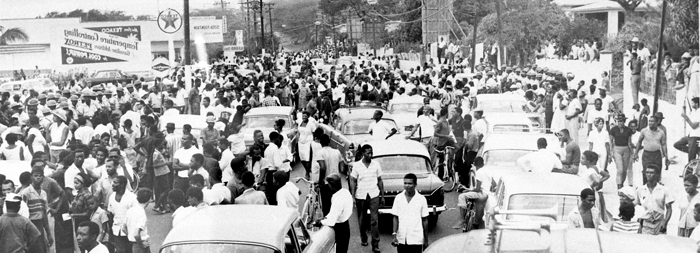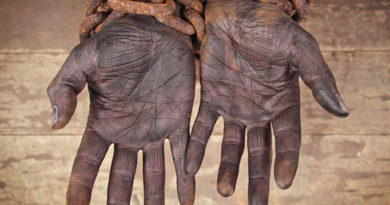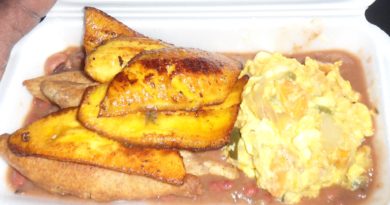History of Jamaica
Jamaica has a rich and unique historical background. Our history is embraced and celebrated by locals and tourists alike. As a result of our history, the Jamaican community is made up of many different races and people from around the globe. In Jamaica you will find people whose ancestors came from Africa, Europe, India, China, the Middle East, and others.
When it comes to the history of Jamaica, there are many people who have contributed both negatively and positively. At the end of the day, whether good or bad, our history clearly shapes the diversity of ourJamaican culture and contributes to who we are today. Let us take you on a little trip down memory lane.
The Tainos: Pre Columbus Inhabitants
 Before Christopher Columbus ever touched Jamaican soil, the Tainos were present throughout several sites around the island. The Tainos were the first Jamaicans. They were native Indians called Arawaks or Amerindians who came to Jamaica about 1000 AD. Due to the deep forestry and the possible dangers posed by wildlife and insects, the Tainos settled near to the coastline. The Tainos soon became slaves to the Columbus and the people from Spain called the Spaniards or Europeans.
Before Christopher Columbus ever touched Jamaican soil, the Tainos were present throughout several sites around the island. The Tainos were the first Jamaicans. They were native Indians called Arawaks or Amerindians who came to Jamaica about 1000 AD. Due to the deep forestry and the possible dangers posed by wildlife and insects, the Tainos settled near to the coastline. The Tainos soon became slaves to the Columbus and the people from Spain called the Spaniards or Europeans.
The Spanish Period (1494-1654)
 Columbus was the first European to set eyes the island on Jamaica on May 3, 1494. He came to Jamaica on his second voyage to the West Indies, then known as the “New World”. Jamaica was not regularly settled by Europeans until November 1509, when Diego Colon, son of Columbus was granted lordship of Jamaica and sent a Governor to take possession. The followers of Columbus soon established themselves in the Island and began building permanent settlements on the north coast, notably in the Parish of Ann.
Columbus was the first European to set eyes the island on Jamaica on May 3, 1494. He came to Jamaica on his second voyage to the West Indies, then known as the “New World”. Jamaica was not regularly settled by Europeans until November 1509, when Diego Colon, son of Columbus was granted lordship of Jamaica and sent a Governor to take possession. The followers of Columbus soon established themselves in the Island and began building permanent settlements on the north coast, notably in the Parish of Ann.
Columbus and his crew had difficulties adapting to life in the tropical surroundings. As a result, they made tremendous demands upon the Tainos for the supply of labor, food and other amenities. The pressure from these harsh work conditions caused the number of Indians to quickly diminish. Within a short period of only 50 years they had ceased to exist as a significant portion of the Island’s population.
In 1533, the Tainos were replaced with African slaves, which marked the beginning of the slave trade. Slaves were bought from Africa, as they were known to have a good work history. In spite of attacks by the English, French, and Dutch, the Spanish held the island for over 145 years, up to the beginning of the English conquest.
The Arrival of the British
 On May 10, 1655, the island was invaded by soldiers led by Admiral Penn and General Venables. The invaders to their surprise found little opposition and soon forced the Spaniards (Spanish) to sign a treaty at Spanish Town. After the Spanish surrendered Jamaica became a British Colony. The Spaniards in the meantime had left for the island of Cuba. Before leaving for Cuba the Spanish slaves were liberated. These African slaves fled to the mountains and soon became the famous “Maroons”.
On May 10, 1655, the island was invaded by soldiers led by Admiral Penn and General Venables. The invaders to their surprise found little opposition and soon forced the Spaniards (Spanish) to sign a treaty at Spanish Town. After the Spanish surrendered Jamaica became a British Colony. The Spaniards in the meantime had left for the island of Cuba. Before leaving for Cuba the Spanish slaves were liberated. These African slaves fled to the mountains and soon became the famous “Maroons”.
In 1657, the biggest battle ever fought in Jamaica took place. Further in 1658 the “Buccaneers” came to Jamaica and had their headquarters at Port Royal. One of the most famous buccaneer was Henry Morgan who eventually was knighted and appointed Lietenant-Governor. Later in 1692, Port Royal was completely destroyed by a devastating earthquake. This is one of the most awful catastrophes ever recorded in Jamaica. At this time, Port Royal was the largest and most important British city in the New World.
Thousands of houses were destroyed, and many thousands of inhabitants were killed in the Port Royal earthquake. The geological structure of the Island was altered and the Government of Jamaica decided to abandon the remains of the ill-fated city. A new settlement was found on a land which was later to become known as the City of Kingston.
The Abolition of Slavery Movement
 By 1807, there was constant and unremitting activities of an anti-slavery group in England. They intensified their activities in 1823 and demanded a final and complete abolition of slavery in all the British possessions.
By 1807, there was constant and unremitting activities of an anti-slavery group in England. They intensified their activities in 1823 and demanded a final and complete abolition of slavery in all the British possessions.
In 1834 there was Emancipation, in spite of the tremendous and influential opposition, slavery was abolished by Act of Parliament. The British people purchased the freedom of 255, 000 slaves for a sum of nearly six million pounds and established a system of apprenticeship that was to last six years. They soon found apprenticeship unworkable and the anti-slavery group in England with theirs representatives in Jamaica continually pressed for complete and final abolition. Final abolition was achieved in 1838 under the Governorship of Sir Lionel Smith.
Following emancipation, Free Villages were established by Baptist Missionaries. The First Free Village was established by Rev. James Phillipo and was called “Sligoville”, which was named after the Marquis of Sligo (Governor of Jamaica). The second Free Village was Sturge Town which is about 8 miles from Brown’s Town, St. Ann.










Pingback: Anansi Stories - About Jamaica
Pingback: Chukka Dune Buggy Adventure - About Jamaica
Pingback: Clarendon - About Jamaica
Pingback: Green Castle Estate Tour - About Jamaica
Pingback: Hooves Jamaica Tour Facts - About Jamaica
Pingback: Jamaica History - About Jamaica
Pingback: Jamaican Culture - About Jamaica
Pingback: Jamaican Riddles - About Jamaica
Pingback: Dominoes in Jamaica - About Jamaica
Pingback: National Heroes of Jamaica - About Jamaica
Pingback: Horse Racing in Jamaica - About Jamaica
Pingback: Major Rivers in Jamaica: Interesting Facts - About Jamaica
Pingback: The Maroons - About Jamaica
Pingback: Montego Bay - About Jamaica